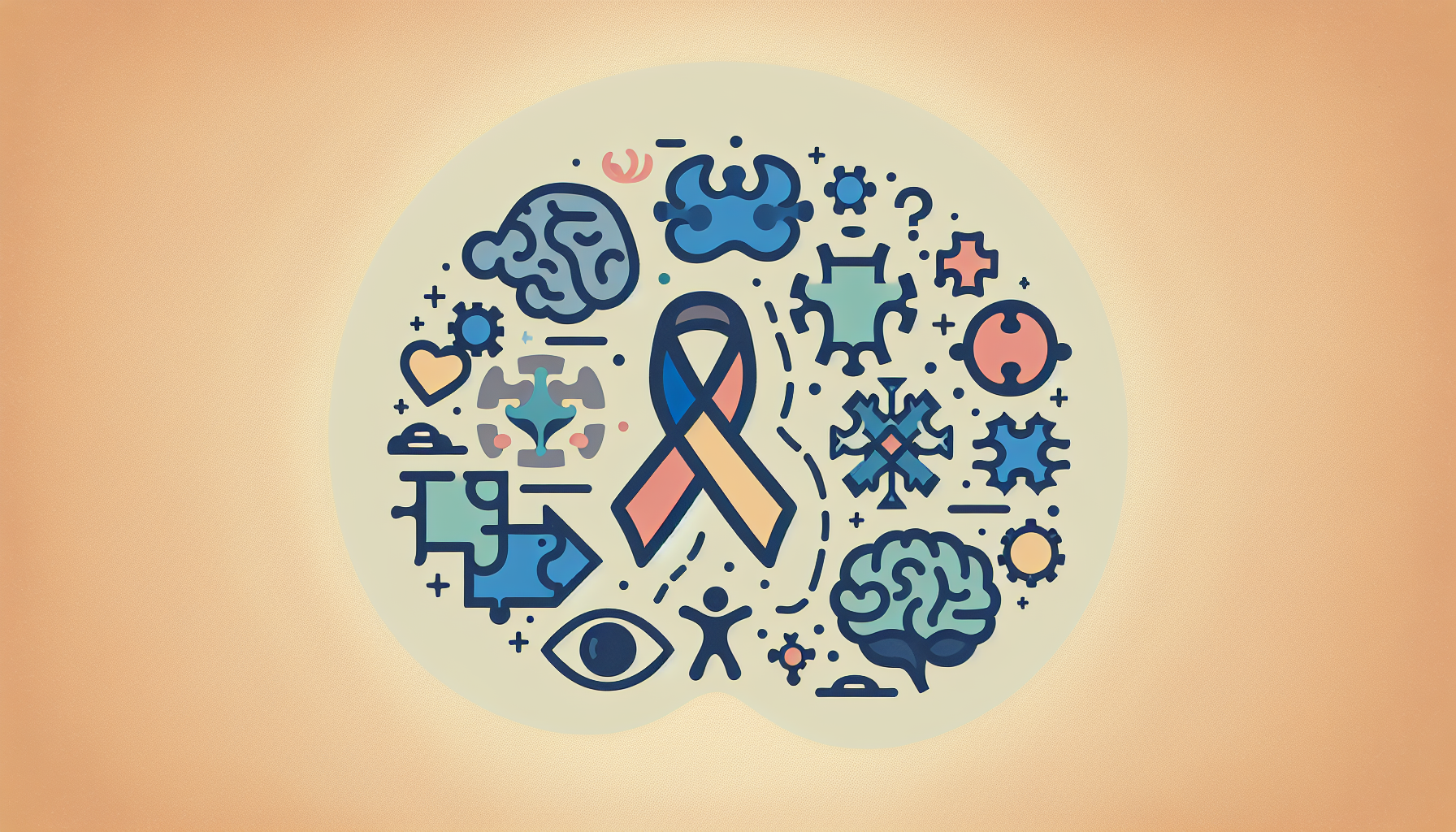Autism Screener: Empathy Unveiled
Embark on a journey of understanding with our autism screener – a compassionate tool designed to open conversations, not just check boxes. Explore the unique stories and experiences behind each question, fostering a human connection in the process.

The Importance of Autism Screening
Autism Spectrum Disorder (ASD) is a neurodevelopmental disorder that affects individuals in various ways, impacting their social communication, behavior, and interactions with the world around them. Early identification and intervention are crucial for individuals with ASD to receive the support they need. This is where autism screening plays a vital role.
Understanding Autism Spectrum Disorder (ASD)
Autism Spectrum Disorder is a complex condition that manifests differently in each individual. It is characterized by challenges in social interaction, communication, and restricted or repetitive behaviors. People with ASD may have difficulties with verbal and non-verbal communication, understanding social cues, and forming and maintaining relationships.
ASD is a spectrum, which means that it encompasses a wide range of abilities and challenges. Some individuals with ASD may have exceptional skills in certain areas, while others may require significant support in their daily lives. Understanding the unique strengths and challenges of individuals with ASD is essential for providing appropriate care and support.

Why Screening for Autism is Essential
Screening for autism is essential for early identification and intervention. Early detection allows for timely support, which can significantly improve the outcomes and quality of life for individuals with ASD. By identifying autism early, individuals and their families can access appropriate services, therapies, and educational resources tailored to their specific needs.
Autism screening helps to identify developmental delays or atypical behaviors that may indicate the presence of ASD. It provides an opportunity for healthcare professionals to assess the individual's strengths, challenges, and developmental milestones. Early intervention programs, such as speech therapy, occupational therapy, and behavioral interventions, can be implemented to address specific areas of difficulty and promote optimal development.
Autism screening is not a diagnostic tool. It serves as an initial step in the assessment process, identifying individuals who may require further evaluation by a specialist. Autism screening questionnaires and tools are commonly used to gather information about a person's development, behavior, and communication skills. These screening instruments help healthcare professionals determine if further diagnostic assessment is necessary.
By recognizing the importance of autism screening, individuals with ASD can receive the support they need to reach their full potential. Early identification leads to early intervention, which is key in providing the necessary tools and strategies for individuals with ASD to thrive. Autism screening is a crucial step in identifying and supporting individuals with ASD, enabling them to lead fulfilling and meaningful lives.
Evolution of the Autism Screening Test
Over the years, the process of diagnosing autism spectrum disorder (ASD) has evolved significantly. The journey of the autism screening test has seen the development of more effective and standardized methods to identify individuals on the autism spectrum. Let's explore the early methods of autism screening and the subsequent development of standardized autism screening tests.
Early Methods of Autism Screening
In the early days of autism screening, healthcare professionals relied on clinical judgment and observation to identify potential signs of autism in individuals. These subjective assessments were based on the presence of certain behavioral characteristics associated with autism. However, the lack of standardized criteria and objective measures made it challenging to achieve consistent and accurate diagnoses.
Development of Standardized Autism Screening Tests
As our understanding of autism deepened, researchers and clinicians recognized the need for more reliable and objective methods of screening for autism. This led to the development of standardized autism screening tests that could be administered in a consistent manner, ensuring a more accurate assessment of individuals.
Standardized autism screening tests are comprehensive tools designed to assess various aspects of an individual's behavior, communication, and social interaction. These tests incorporate specific criteria and scoring systems to aid in the identification of autism symptoms. By utilizing established guidelines, these screening tests provide a more structured and reliable approach to diagnosing autism.
Let's take a closer look at some commonly used autism screening tests:
Autism Screening Test and Description
- Autism Diagnostic Observation Schedule (ADOS): ADOS is a widely recognized and comprehensive test that involves direct interaction and observation of an individual by a trained professional. It assesses communication skills, social interaction, and play behaviors.
- Childhood Autism Rating Scale (CARS): CARS is a behavior rating scale that focuses on observing and rating various behaviors associated with autism. It provides a standardized approach to evaluating social interactions, communication, and repetitive behaviors.
- Modified Checklist for Autism in Toddlers (M-CHAT): M-CHAT is a screening questionnaire designed for toddlers between 16 and 30 months of age. It consists of a series of questions that assess various behaviors associated with autism. The questionnaire is typically completed by parents or caregivers.
These standardized autism screening tests have greatly contributed to the early identification and diagnosis of autism. They provide a more systematic and objective approach, reducing the subjectivity that was present in earlier methods of screening. By utilizing these tests, healthcare professionals can obtain a clearer picture of an individual's behaviors and determine whether further evaluation for autism is necessary.
The evolution of the autism screening test has played a crucial role in improving the early identification of autism spectrum disorder. By identifying individuals on the autism spectrum at an early stage, appropriate interventions and support can be provided, leading to better outcomes and a higher quality of life for individuals with autism and their families.
Commonly Used Autism Screening Tests
To accurately identify and assess autism spectrum disorder (ASD), various standardized screening tests have been developed and widely used. These tests help to evaluate a range of behaviors and symptoms associated with ASD. Here are three commonly used autism screening tests:
Autism Diagnostic Observation Schedule (ADOS)
The Autism Diagnostic Observation Schedule (ADOS) is a comprehensive assessment tool that involves direct observation of the individual being screened. It is typically administered by a trained professional, such as a psychologist or speech-language pathologist. The ADOS assesses social communication, interaction, and play skills across different developmental stages.
The ADOS consists of various activities and tasks designed to elicit specific behaviors associated with ASD. The professional administering the test closely observes and scores the individual's responses and behaviors during the session. The results are then interpreted to determine the likelihood of ASD.
Childhood Autism Rating Scale (CARS)
The Childhood Autism Rating Scale (CARS) is a widely used screening tool that helps assess the severity of autism symptoms in children. It is typically completed by a caregiver, teacher, or healthcare professional who is familiar with the child's behaviors. The CARS consists of 15 items that cover various aspects of social interaction, communication, and behavior.
Each item on the CARS is rated on a scale from 1 to 4, with higher scores indicating more severe autism symptoms. The ratings are based on the observer's judgment of the child's behaviors and characteristics. After completing the assessment, the scores are totaled and interpreted to determine the presence and severity of ASD.
Modified Checklist for Autism in Toddlers (M-CHAT)
The Modified Checklist for Autism in Toddlers (M-CHAT) is a widely used screening questionnaire designed to identify early signs of ASD in toddlers between the ages of 16 and 30 months. It is typically administered by a healthcare professional or caregiver who is familiar with the child's behavior.
The M-CHAT consists of a series of questions about the child's social communication skills and behaviors. The caregiver or professional responds to the questions based on their observations of the child. Depending on the responses, further evaluation may be recommended to determine the likelihood of ASD.
These screening tests, along with other autism screening tools and instruments, play a crucial role in the early identification and diagnosis of ASD. They provide valuable insights into the presence and severity of autism symptoms, enabling individuals and their families to access appropriate support and intervention.
Administering the Autism Screening Test
When it comes to administering an autism screening test, it's important to understand who conducts the screening and what to expect during the process. This section will provide insights into these aspects to help you navigate the screening experience.
Who Conducts the Screening?
Autism screenings are typically conducted by healthcare professionals who specialize in developmental disorders, such as pediatricians, psychologists, or psychiatrists. These professionals have the knowledge and expertise to administer and interpret the screening tests effectively.
In some cases, other trained healthcare providers, such as speech-language pathologists or occupational therapists, may also be involved in the screening process. Their specific roles may vary depending on the setting and the resources available.
It's important to seek out qualified professionals who are experienced in autism screening and have a comprehensive understanding of the screening tools available. They can guide you through the process, provide accurate information, and offer support during the screening and beyond.
What to Expect During the Screening Process
The screening process for autism typically involves a series of assessments and evaluations. The specific tests used may vary depending on the age of the individual being screened and the healthcare provider's preference. Here are some key aspects to expect during the screening process:
- Interview and Observation: The healthcare provider may conduct an interview with the individual being screened and their caregiver(s) to gather information about the individual's behavior, development, and any concerns. They may also observe the individual's social interaction, communication skills, and play behavior.
- Questionnaires and Checklists: The healthcare provider may ask the caregiver(s) to complete questionnaires or checklists that provide additional information about the individual's behavior and development. These questionnaires help assess specific areas related to autism symptoms and developmental milestones.
- The autism screening questionnaire is a commonly used tool to gather information about a child's behavior and development.
- Various autism screening tools and autism screening instruments are available to aid in the screening process.
- Direct Assessment: The healthcare provider may conduct direct assessments to further evaluate the individual's social communication skills, behavior, and sensory processing. These assessments may involve structured activities, play-based interactions, and standardized tests.
The screening process aims to assess the presence or absence of autism-related behaviors and determine if further evaluation or diagnosis is necessary. Screening test does not provide a definitive diagnosis of autism but serves as an initial step in identifying potential concerns.
Remember, the screening process may vary depending on the healthcare provider and the specific tools they use. Open communication with the healthcare provider is key to understanding the process, asking questions, and addressing any concerns you may have.
In the next section, we will explore how the results of the autism screening test are interpreted and the next steps that follow.
Interpreting the Results
After completing an autism screening test, it's important to understand how to interpret the results. The scoring system used in the test provides valuable insights into the likelihood of autism spectrum disorder (ASD). Here, we will explore the understanding of the scoring system and the next steps that follow after the screening.
Understanding the Scoring System
The scoring system of an autism screening test is designed to categorize individuals into different likelihood categories based on their responses. The specific scoring criteria may vary depending on the screening test used. However, generally, higher scores are indicative of a higher likelihood of ASD.
An autism screening test does not provide a definitive diagnosis of ASD. Instead, it serves as an initial step in identifying individuals who may benefit from further evaluation by a qualified healthcare professional. The screening test helps to identify potential red flags and signs that warrant a more comprehensive assessment.
Next Steps after the Screening
If the screening test suggests a likelihood of ASD, the next step is to consult with a healthcare professional who specializes in autism diagnosis and treatment. They will conduct a comprehensive evaluation, which may include additional assessments, observations, and interviews with the individual and their caregivers.
During this evaluation process, the healthcare professional will gather detailed information about the individual's developmental history, behavior, and social interactions. They will also consider other factors that may contribute to the observed symptoms. The evaluation aims to provide a comprehensive understanding of the individual's strengths, challenges, and needs.
Based on the evaluation results, the healthcare professional will determine whether the individual meets the criteria for an autism spectrum disorder diagnosis. If a diagnosis is made, they will work collaboratively with the individual and their caregivers to develop a personalized treatment plan. This plan may include various therapies, interventions, and support services tailored to the individual's unique needs.
It's important to remember that early intervention is key in supporting individuals with autism. If the screening test indicates a likelihood of ASD, it is crucial to seek further evaluation and support as soon as possible. Early intervention can greatly benefit individuals with autism by providing them with the necessary tools, strategies, and support to thrive in their daily lives.
The Impact of Early Autism Screening
Early autism screening plays a crucial role in identifying autism spectrum disorder (ASD) in individuals, leading to timely intervention and support. By detecting signs of autism at an early stage, individuals with autism and their families can access the necessary resources and interventions to promote their overall development and well-being.
Early Intervention and Support
Early autism screening allows for early intervention, which is vital for individuals with autism. Through early identification, children can receive specialized therapies, such as applied behavior analysis (ABA), speech therapy, occupational therapy, and social skills training. These interventions are designed to target specific areas of development affected by autism, such as communication, social interaction, and behavior.
Research has shown that early intervention can significantly improve outcomes for individuals with autism. It can enhance their language skills, social interactions, adaptive behavior, and cognitive abilities. With appropriate support and early intervention services, individuals with autism can gain the skills necessary to navigate daily life more independently.
Empowering Individuals with Autism and Their Families
Early autism screening not only benefits individuals with autism but also empowers their families. By identifying autism at an early stage, families can access resources, support groups, and educational programs tailored to their specific needs. They can connect with other families going through similar experiences, creating a network of support and understanding.
Early screening enables families to better understand their child's unique strengths, challenges, and individualized needs. Armed with this knowledge, they can make informed decisions about their child's education, therapy options, and long-term planning.
Moreover, early autism screening helps reduce the uncertainty and stress that families may experience when trying to understand their child's behavior and developmental differences. It provides a roadmap for accessing appropriate services and support, empowering families to advocate for their child's needs effectively.
Summary
Let's remember that this tool is not just about ticking boxes; it's a guide to understanding, compassion, and support. Each question is a doorway into the unique world of an individual on the autism spectrum, a chance for us to connect with their experiences and appreciate their uniqueness.
The autism screener is a human touchpoint in a sometimes complex process. It's a conversation starter, an opportunity for caregivers, families, and professionals to come together and understand a person's journey. It's not about fitting someone into a predefined category; it's about tailoring support to their specific needs.
So, as we use this screener, let's approach it with empathy, acknowledging that every person is more than the sum of their answers. In the realm of autism, understanding is the bridge to meaningful support and acceptance, and every step taken with compassion brings us closer to creating a world that embraces neurodiversity with open hearts.
Sources
Find More Articles
Contact us
North Carolina, Tennessee, Nevada, New Jersey, Utah, Virginia
New Hampshire, Maine
Massachusetts, Indiana, Arizona, Georgia
.avif)










































.jpeg)









.jpeg)
.jpeg)



.jpeg)
















.jpeg)
.jpeg)



.jpeg)
.jpeg)











.jpeg)



.jpeg)



.jpeg)
